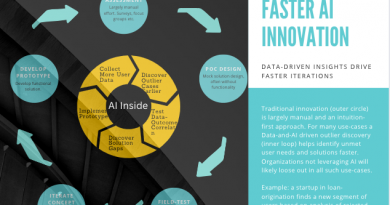New Art of Prototyping
New Art of Prototyping
Deepam Mishra | AI-inside series
The new AI-Inside methodology of prototyping turns the conventional assumptions on their head.
Unfortunately, as per my survey, more than 70% corporates are still largely following the conventional methods of new product prototyping, which can often take a minimum of 6 months per iteration. Whereas, as can be seen from the below suggestions, disruptive AI-innovators are able to move in days and weeks. They are able to gain a 80% to 90% compression on timelines in innovation. Not only is this time-compression a huge advantage (time-to-market) in of itself, I have anecdotally noted that in most cases delayed projects often die an un-natural death due to variety of non-market reasons.
Who Needs A Back-End Anymore?
With the advent of rapid front-end prototyping tools (e.g Figma), developing a “works-as” product concept, including animating each of its buttons and workflows, is a trivial task for anyone — no technical training required. Startups who I work with, routinely prototype entire product concepts in 1 to 2 days: from whiteboard to putting a test concept in front of a customer. You don’t need to build any backend capabilities until you are satisfied with the product-market-fit. The rules of the game have changed. There is a reason why Figma was acquired for $20B by Adobe.
AI is Old News
Using AI to generate insights or to demonstrate new capability to test customers can also be a trivial task today. Most people do not realize that machine learning has been around for almost 20 years. The big difference today is that it is easier to execute at cloud-scale and pre-built tools are provided by literally 100s of providers. There is no reason to build a highly accurate AI model without first testing a pre-built model, albeit 80% accurate. All major cloud providers (GCP, AWS, Azure, IBM etc.) provide all common forms of AI models — NLP, computer-vision, segmentation, forecasting, predictions etc. New innovators have no excuse to leveraging AI in their early prototypes.
Sell-Then-Build
A common mistake that I have made and observed, amongst new product innovators, is to test a new product concept with potential customers without asking customers to think about making a price. And then when they launch the product, they often find customers are not interesting in investing time and/or money. Is that any surprise? Today, using data and AI, one can build in several “value checking hurdles” along the customer path to see if the customer is willing to invest, at least a bit. Otherwise, you may be just fooling yourself about the need.





